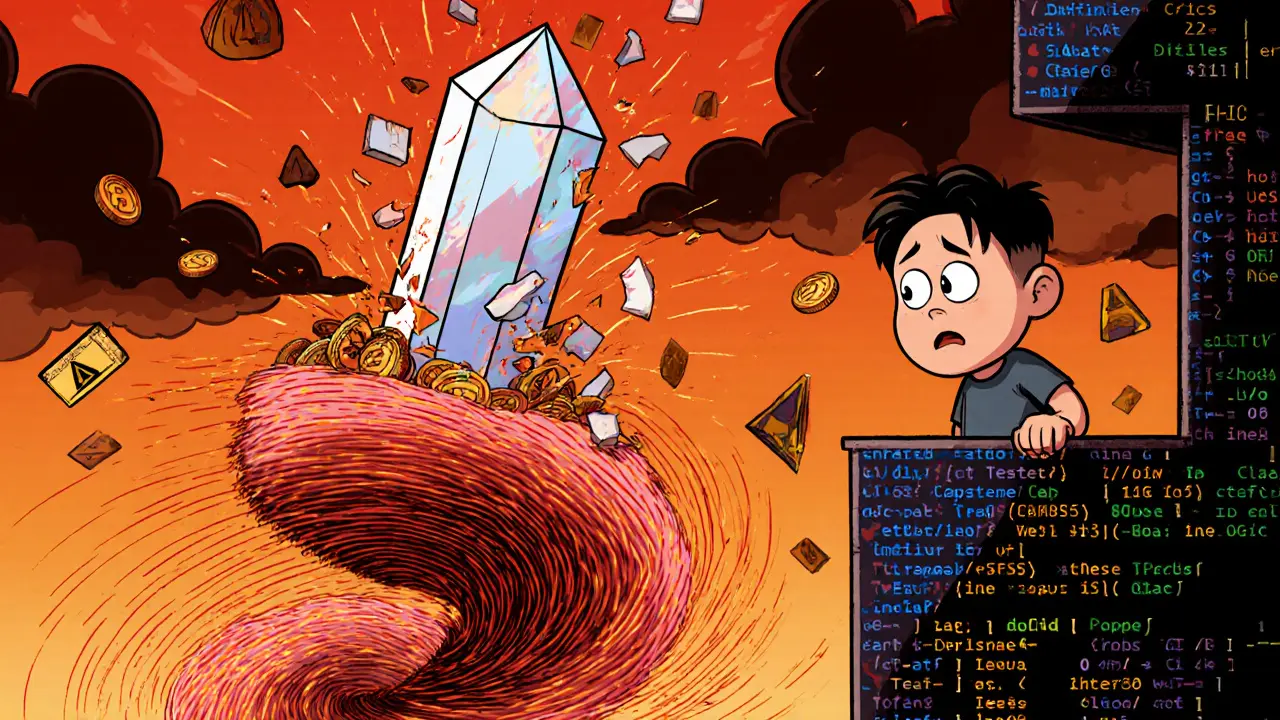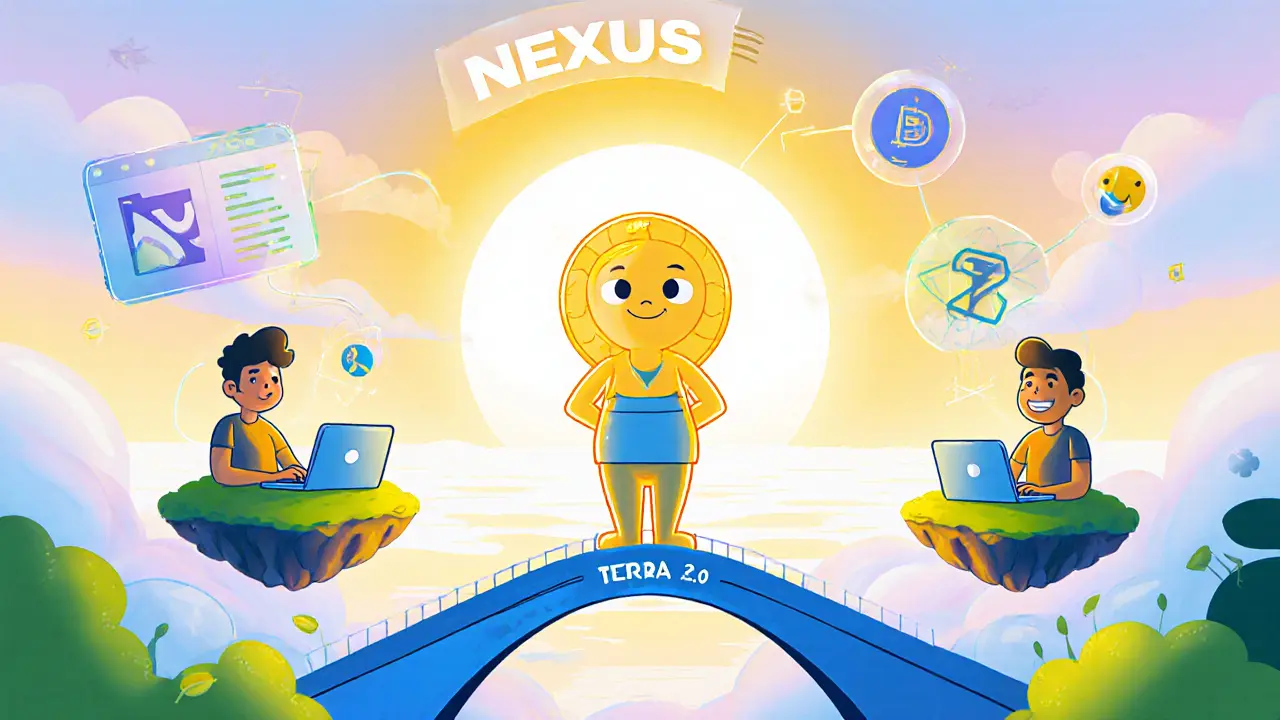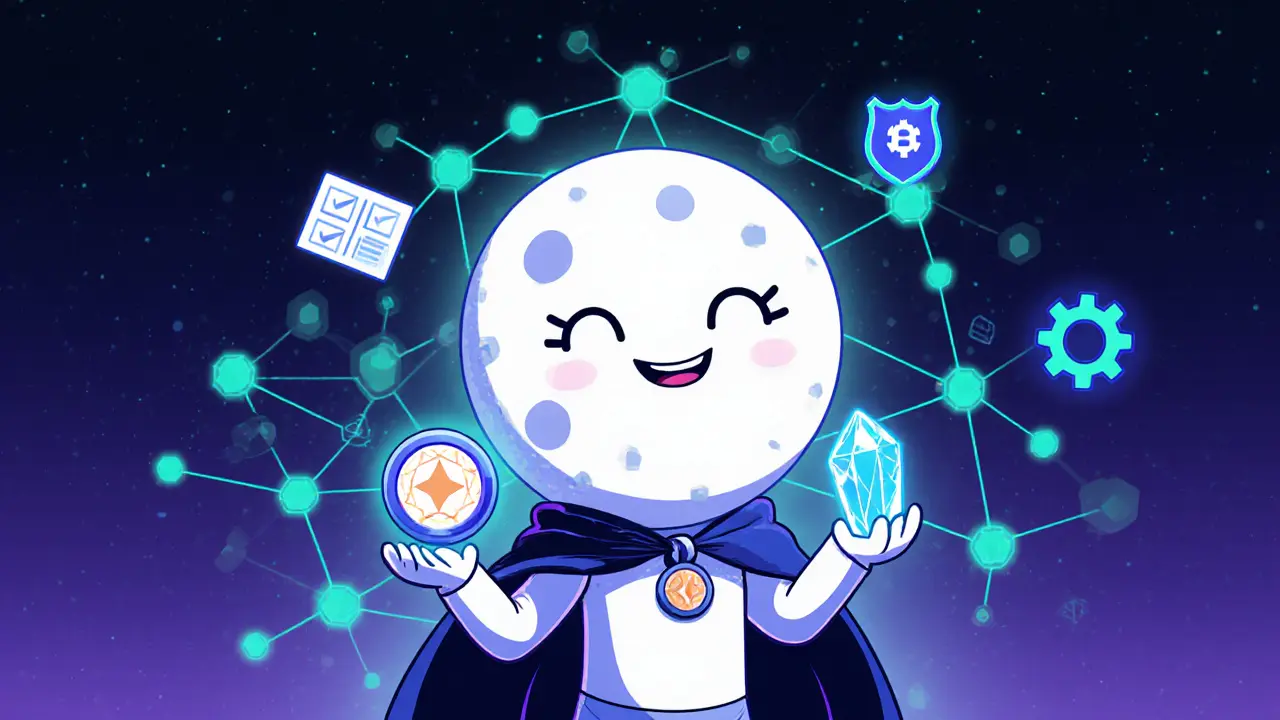LUNA Staking Calculator
Estimate your potential annual staking rewards based on current Terra 2.0 network parameters
Estimated Rewards
Important Notes: Staking involves risks including validator slashing and network downtime. Current LUNA price is $0.22 (as of May 2025). Always research and secure your private keys.
If you’ve seen headlines about a crypto called Terra (LUNA) and wondered what the buzz is about, you’re not alone. The coin has been through a dramatic crash, a hard fork, and a full‑blown rebirth. This guide walks you through the whole story, the tech that powers the current LUNA, and where the market stands today.
What is Terra (LUNA)?
Terra (LUNA) is a cryptocurrency that serves as a governance and staking token for the Terra 2.0 blockchain. It originally launched in 2019 alongside an algorithmic stablecoin called UST, but after a catastrophic failure in 2022 the ecosystem split into two separate chains: Terra Classic (LUNC) and the newly‑minted Terra 2.0 (LUNA). The modern LUNA no longer powers a stablecoin; instead, it helps holders vote on protocol upgrades and earn staking rewards.
The Rise and Fall of the Original Terra
The first Terra protocol was built by South Korean entrepreneur Do Kwon and his company Terraform Labs. Its claim to fame was an algorithmic stablecoin, UST, which kept a 1:1 peg to the US dollar through a burn‑and‑mint mechanism involving LUNA. Users could burn $1 of UST to receive $1 worth of LUNA and vice‑versa, theoretically keeping the price stable.
In May 2022 that system unraveled. UST lost its peg, sparking a “death spiral” that wiped out roughly $40 billion in market value in a matter of days. The collapse led to a hard fork on May 28 2022, creating two divergent blockchains.
Terra Classic (LUNC) - The Legacy Chain
Terra Classic retained the original chain and its native token LUNC (formerly LUNA). It continues to host the dead UST stablecoin, now called USTC, but without any official backing. With a circulating supply of about 6.49 trillion LUNC and a market cap under $400 million, it functions more like a meme‑coin than a utility platform. Community sentiment is split: some hold on hope of a future resurgence, while many have moved on after the massive loss.

Terra 2.0 - A Fresh Start
Terra 2.0 launched as a brand‑new blockchain that discarded the algorithmic stablecoin model entirely. Its LUNA token is solely a governance and staking asset. By May 2025, LUNA trades around $0.22, a tiny fraction of its 2022 all‑time high of $119.18, but it shows steady recovery compared with the near‑zero price of LUNC.
The new chain runs on a modified Cosmos SDK, which gives it built‑in compatibility with the Inter‑Blockchain Communication (IBC) protocol. This means Terra 2.0 can talk to other Cosmos‑based networks, opening doors for cross‑chain DeFi applications.
Technical Architecture and Ecosystem
Key technical differences between Terra Classic and Terra 2.0 include:
- Token role: LUNC acts as a volatile price absorber for USTC, while LUNA is a pure governance token.
- Supply: LUNC’s 6.49 trillion supply dwarfs LUNA’s 1.12 billion circulating tokens.
- Consensus: Both use Tendermint BFT, but Terra 2.0 has upgraded its validator set to improve decentralization.
- Interoperability: IBC enables assets to move between Terra and other Cosmos chains like Osmosis and Cosmos Hub.
Developers can write smart contracts in Rust or CosmWasm, giving them the ability to create DeFi protocols, NFT marketplaces, and gaming dApps. The ecosystem currently hosts around 350 active developers, which is modest compared with Ethereum’s thousands, but it’s growing as the “Aurora” upgrade adds EVM compatibility.

Market Performance and Community Sentiment
As of May 2025, Terra 2.0 holds about 0.048 % of the total crypto market, roughly $1 billion in value. Daily trading volume averages $287 million across Binance, Coinbase, and OKX. By contrast, Terra Classic’s market cap sits near $325 million with far lower liquidity.
Community engagement tells a mixed story. The official Terra 2.0 Discord swelled to over 84,300 members by May 2025, with weekly active participants hitting 9,400. Meanwhile, Trustpilot reviews for Terra‑related services linger at 2.3 / 5, reflecting lingering skepticism from the 2022 crash. Reddit threads still feature heated debates: some users plan to hold LUNA only after it proves a six‑month streak above $1, while others see the rebirth as a genuine second chance.
Roadmap and Future Outlook
Key upcoming milestones include:
| Quarter | Upgrade | Key Feature |
|---|---|---|
| Q3 2025 | Aurora | EVM compatibility - lets Ethereum dApps run on Terra |
| Q1 2026 | Nexus | Boosts throughput to ~5,000 TPS, improves gas fees |
| 2026‑2027 | Governance Expansion | More on‑chain voting power for LUNA stakers |
Price forecasts diverge sharply. Optimistic models from OKX predict LUNA could hit $0.95 by late‑2025, while bearish analysts at CoinCodex see a drop to $0.07. The reality will likely hinge on how quickly the Aurora upgrade attracts Ethereum developers and whether the Nexus protocol delivers its promised speed gains.
Regulatory headwinds have eased a bit after the GENIUS Act banned interest‑bearing algorithmic stablecoins, indirectly benefiting Terra 2.0 by removing its biggest historical flaw. However, global scrutiny of crypto projects with controversial founders remains high, especially given Do Kwon’s arrest in 2023.
Key Takeaways
- Terra (LUNA) today is a governance and staking token on the Terra 2.0 blockchain, not an algorithmic stablecoin.
- The ecosystem split into Terra Classic (LUNC) and Terra 2.0 after the 2022 UST crash.
- Technical upgrades like Aurora (EVM) and Nexus (throughput) aim to broaden adoption.
- Market share is modest but growing; community sentiment is cautiously optimistic.
- Future price depends on developer migration, upgrade success, and regulatory clarity.
Is Terra (LUNA) the same as the coin that crashed in 2022?
No. The original LUNA that backed the UST stablecoin was renamed Terra Classic (LUNC). The current LUNA belongs to Terra 2.0, a brand‑new chain without the algorithmic stablecoin mechanism.
How can I buy Terra (LUNA) today?
LUNA is listed on major exchanges like Binance, Coinbase, and OKX. You’ll need a compatible wallet (e.g., Keplr or Ledger with updated firmware) to store it safely.
What are the main uses of LUNA?
LUNA is primarily used for staking (earning rewards), governance voting on protocol upgrades, and as collateral in DeFi applications built on Terra 2.0.
Is staking LUNA safe?
Staking is relatively safe, but you still face risks like validator downtime or slashing. Always choose reputable validators and keep your private keys secure.
What’s the difference between LUNA and LUNC?
LUNA runs on Terra 2.0 and serves governance and staking. LUNC (formerly LUNA) remains on the original chain with the now‑defunct USTC stablecoin and a vastly larger supply.

15 Comments
Ray Dalton
Terra 2.0 is actually kinda impressive if you strip away the drama. No more algorithmic stablecoin mess? Good. IBC integration means real cross-chain utility now, not just hype. The EVM upgrade in Q3 is the real test - if devs start building there, this could actually become a serious player again.
Peter Brask
LMAO they think this is a 'fresh start'?? 😂 Do Kwon’s still out there laughing at all the sheep who bought LUNA again. This is just a rebrand for the same scammers. The whole Cosmos chain is a Ponzi with better UI. They’ll crash again when the next rug pull hits. 🚨💸
Trent Mercer
Let’s be real - Terra 2.0 is just a glorified sidechain with a fancy name. The fact that it needs EVM compatibility just proves it can’t stand on its own. And 350 developers? That’s cute. Ethereum has 15,000. This isn’t a comeback, it’s a footnote waiting to happen.
Kyle Waitkunas
They say it’s a 'new chain' but the same people are running it - the same people who lied about UST being 'decentralized' and 'algorithmically stable' - and now they’re back with a new token and a new story? This isn’t recovery, this is psychological warfare. The regulators are watching. The SEC is already drafting charges. They’re not rebuilding - they’re reeling in the same gullible crowd. I’m not buying it. Not again. Not ever. 🚫😭
vonley smith
Don’t sleep on the Aurora upgrade. If it actually brings over even a fraction of Ethereum devs, this could be the quiet comeback story of 2025. Staking rewards are decent, the team’s been quiet but consistent, and the community’s smaller but way more real than before. Take it slow, don’t FOMO, but don’t write it off either.
Melodye Drake
It’s amusing how people still treat this like a legitimate project. The entire foundation was built on lies, and now they’re repackaging the same toxic ideology with a new token symbol. If you’re still holding LUNA, you’re not investing - you’re just emotionally attached to a trauma. 🤷♀️
paul boland
USA thinks it owns crypto now? 😒 Ireland’s got better tech than this. Terra 2.0 is just American delusion wrapped in blockchain jargon. IBC? More like I-Believe-It’s-Back. The whole thing’s a joke. 🇮🇪❌
harrison houghton
There is a fundamental philosophical error in the way people perceive this rebirth. The concept of a 'fresh start' is an illusion. The past is not erased by a hard fork. It is embedded in the memory of every holder, every exchange, every regulatory body. To believe otherwise is to misunderstand the nature of trust. Trust is not code. Trust is human. And humans remember.
DINESH YADAV
USA and Europe think they invented blockchain. India has real tech. Terra 2.0 is just a Western scam with a new name. We have our own chains - faster, cheaper, real. Why are you still talking about this? LUNA is dead. Move on.
rachel terry
Why does everyone keep calling it Terra 2.0 like it’s an upgrade? It’s not. It’s a reboot. A reboot of a failed system. And now they’re pretending it’s not the same people? Please. The whole thing’s a rebrand. No one’s fooled. Not even the people who bought in.
Susan Bari
Market cap under a billion? That’s cute. The real story is how quiet the team has been. No grand announcements. No influencers. Just code. That’s the sign of something real - not hype. I’m not bullish. I’m just not bearish anymore.
Sean Hawkins
From a technical standpoint, the shift to pure governance + staking is a significant architectural improvement. The removal of the unstable UST mechanism eliminates the single point of failure that doomed the original. The Cosmos SDK foundation is robust, and IBC interoperability is non-trivial - this isn’t just a rebrand, it’s a legitimate pivot. The real risk now is adoption velocity, not protocol design.
Marlie Ledesma
I lost everything in the crash. I didn’t touch crypto for two years. But I watched Terra 2.0 slowly rebuild - no hype, no influencers, just devs working. I bought a little LUNA last month. Not to get rich. Just to see if they’re really different this time. I’m not cheering. I’m just… watching.
Daisy Family
lol terra 2.0 is just luna with a haircut and a new instagram bio. they think we dont remember the memes? the panic? the 99% drops? nah fam. this is just the same scam with a new logo. 🙃
Paul Kotze
Interesting to see how the community’s evolved. Before, it was all about UST yields and moon missions. Now it’s about developer activity, validator decentralization, and real use cases. That’s maturity. It’s slow, it’s quiet, and it’s not flashy - but it’s the kind of growth that lasts. I’m not holding for a 10x. I’m holding because the foundation feels solid now.